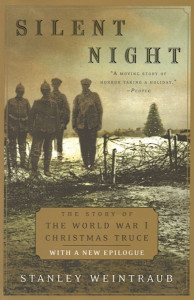A century ago an incredible event occurred Christmas Eve and Christmas Day along No Man’s Land between Belgium and France. What was more and more becoming known as World War I or the Great War experienced a populist movement that brought fighting to an abrupt halt between all the warring armies. Briefly there was a faint glimpse of hope that the cease-fire might be sustained.
Men from around the globe were then along the Western Front. France and England had reinforcements from their colonies in Africa, India, the Middle East, Australia, Canada, New Zealand, and Southeast Asia to fight alongside their own armies. Germany and Austria-Hungary were fortified with troops from parts of the Middle East and the Balkans.
Since mid-September, the Western Front was the scene of muddy trenches, rolls of barbed wire, and bodies dead or dying in the mud and snow. Retrieving the dead was an ordeal, occurring only when the high command ordered a brief halt to the incessant artillery fired.
Many of those fighting had never seen snow, didn’t celebrate Christmas, and barely understood French, German, or English. It was a weary time of constant fighting, deplorable conditions, and restriction in damp, dank, filthy trenches. For many those across No-Man’s Land were not enemies, just victims of political and military leaders as they all were.
Early in December, the newly elected Pope Benedict XV appealed for a Christmas cease-fire. Both sides quickly rebuffed the plea. Yet the idea caught hold in the trenches. No one can say for certain where or by whom the cease-fire originated. All of the armies had distributed gifts of food, cigars, pipe tobacco, and cigarettes to their men. Bottles of wine and liquor suddenly appeared. For the German soldiers a Christmas tree was the epitome of the holiday season. From up and down the trench lines, German soldiers crawled out onto No Man’s Land with candle lit trees. Soldiers broke out into Christmas Carols, toasts, and cheers. The men were fed up with fighting!
The festivities continued until after mid-night. Early the next morning heads popped up over the trench walls. Was the cease-fire in effect? Truly it was, but this time enemies met along the neutral zone to exchange trinkets and food. One of the most popular mementoes was the Pickelhaube that spiked helmet worn by German soldiers and a distinct target for Allied sharpshooters.
All up and down the Western Front soccer balls, to Americans, magically found their way onto a make-do “football” fields between the lines. As quickly as the cease-fire began it was quashed by high-ranking officers on both sides. For a few hours, the horrors of war were forgotten, the enemy was seen as another human being, and everyone hoped for a continued truce.
Unfortunately, it would be almost four more years and hundreds of thousands lives lost before the firing stopped. Without the work of historian Stanley Weintraub in his Silent Night: The Story of The World War I Christmas Truce, the story would be unknown to us today. It is a beautiful story of hope amidst great despair. I encourage everyone to check it out at the Greenville library for a good read.

